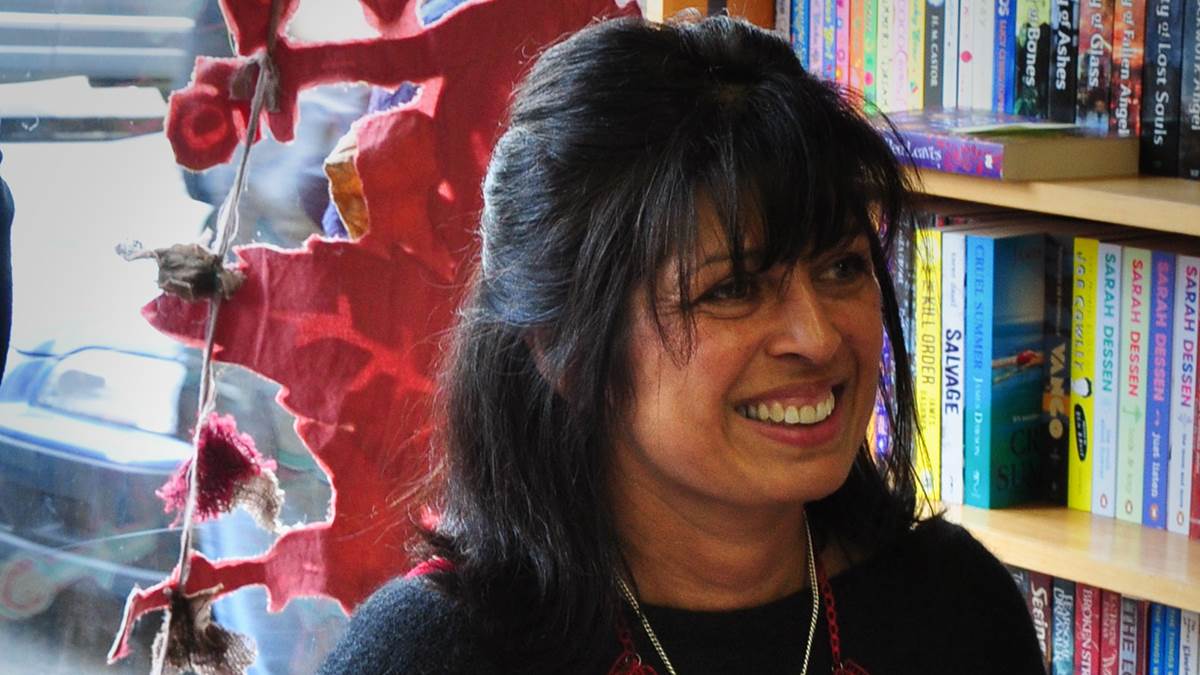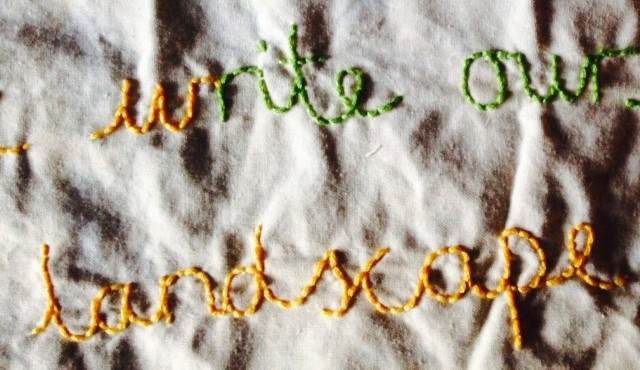Meeting the writers you love
Published on: 13 April 2015 Author: Sita Brahmachari
The brilliant award winning author and campaigner Sita Brahmachari, who's work includes the Zebra Crossing Soul Song and Artichoke Hearts, became our twelfth Writer in Residence back in 2015. In this blog Sita wrote about meeting authors you love, being that author, and her daughter preferring other writers to herself.

Why meeting an admired author, in this case Miriam Halahmy, is just as inspiring for me as it can be for the youngest child.
Reading back over a brainstorm of blog posts I might write over the next six months for Book Trust I found this note to self! 'Meet Miriam Halahmy'. In this blog I want to share with you that very special meeting.
'Among many things, I am British, a woman, a writer, a citizen of the world, a mother and I am Jewish. All of the different parts of my identity underpin my work as a writer and nothing can be separated out. (In conversation with Miriam Halahmy Spring 2015)'
When I visit schools and festivals I find that readers are so keen to meet the writers of the books they love. I feel the same way when I meet an author whose work I admire... and I find myself asking the same sorts of questions that children love to ask.
For me one such author is Miriam Halahmy. A few years ago I read Miriam Halahmy's gritty, humane and moving book Hidden which is part of her cycle of three YA novels (Hidden, Illegal and Stuffed, published by Albury Books.) Hidden tells the story of two teenagers who hide an asylum seeker to save him from being deported. As I read the book I wondered what the writer's experience of life had been. What had brought her to write these stories?
Stories about refugee and migrant groups
I have worked with refugee and migrant groups throughout my work in community theatre and especially on a co-adaptation of Shaun Tan's graphic novel The Arrival (the playscript is published by Bloomsbury) and in the community interactions with Iceandfire Theatre company and Write to Life, both organisations with a passion for bringing the stories of migrants, asylum seekers and refugees beyond what is offered in political sound bites.
The stories of those in search of a safe place to find home have also found their way into my novels. The characters of Jide Jackson a Rwandan refugee in Artichoke Hearts and more recently Aisha a Somali refugee in Red Leaves (Published by Macmillan Children's Books and endorsed by Amnesty International) emerged as a result of working with refugee groups. So I was interested to talk to Miriam about this common experience.
About Miriam
Before I contacted Miriam I decided to do a little research or... as one young girl who greeted me on a school visit described it 'I 'checked her' on her website!'
There I found out so much more about Miriam's work than I had previously known. Not only about her books but that she has been a teacher for 25 years. She's a poet, activist, writing mentor, workshop leader and peace-advocate. Miriam has lead groups meeting across the Middle East divide and believes that all communities can build bridges and reconcile differences. She is an active member of English Pen and a passionate defender of freedom of speech.
Many of these things I had already gleaned when reading her novels but it's strangely satisfying to be able to see how someone's life and work fuels the energy for their creativity.
In this social media age there are many ways to 'meet' a writer but I still feel that there is no substitute to meeting an author in person.
Meeting Miriam
Miriam and I met on a sunny spring day in a park where both of us had once pushed our children in prams. We spoke of our shared experience of the paths we walked and our first connection was personal. Miriam showed me a picture of her grandson and spoke of how much he meant to her. Just as when children meet an author they tend to like to know something heart-felt, funny, quirky and individual about you, the sort of thing that isn't shared on an official website, this felt like a good way to begin meeting the author.
The second connection was talking about the world and our shared experiences. Again I think that's an essential link to make with any reading audience. What are our shared concerns about the world? What preoccupies our thoughts? It's also a connection we make when we read books. How do I connect to this story? Who do I connect with in this story? Meeting the author allows you to ask another really searching question. How does this author's life, loves and passions connect to their work?
Promoting freedom of expression
Miriam began by talking of her work with English Pen, the founding centre of a global literary network, working to defend and promote freedom of expression and remove barriers to literature.
The slogan of English Pen is 'The pen is mightier than the sword'. Miriam acts as consultant and facilitator for PEN on their writing programmes with asylum seekers. Out of this work and her writing, Miriam was invited in October 2014 to run workshops on peace and tolerance in a Paris Lycée, with students from France, Germany, Spain and Turkey.
The following quote is taken from a moving write up of this visit found here:
'As an Anglo/Jewish author, whose great uncle had been deported from Paris to Auschwitz, and who had written a novel (Hidden, Albury Fiction) about Muslim asylum seekers, how would I be received in a Paris school? I needn't have worried - I had the most amazing time!'
School visits and building bridges
The school Miriam visited in Paris has a significant number of Muslim students. Miriam's work took place only a few months before the Paris terror bombings in January 2015 in which people of all faiths were murdered. Miriam spoke about her sense of devastation for all the teachers and the young people she had met and worked with.
She remembered that as she approached the school there were young people handing out leaflets protesting against the Palestinian/Israeli conflict. Once inside the school when it emerged from her writing and her work that she is Jewish, the students were keen to know Miriam's view of the conflict.
'I was the only Jewish person in the room.' She told me. It was a key moment and Miriam had known that this question would come. She had only one answer.
'This is my view. I am not Pro-Israeli, I am not Pro-Palestinian. I am Pro- Peace.'
Her answer made a huge impact on the students.
As Miriam explained, in the times we live in 'It would be easy for me to retreat from this sort of interaction but I put myself in this place because I believe that all communities can build bridges. In my experience, young people are very interested in peace and are open to hearing new ideas and new possibilities. They are really hungry to hear different viewpoints. One of the students wrote in her feedback,
'I learnt it is ok if you don't know what you would do in a situation.' Another said, 'We are better collaborating than we think.'
Miriam's life and background
I asked Miriam about how this work connects personally to her. She felt that there are a range of influences, including her grandparents' stories of fleeing anti-Semitism in 19th century Russia and seeking asylum in the UK; her own childhood growing up after the Holocaust; her work with asylum seekers in schools, and later with English Pen and the Medical Foundation for the Victims of Torture; and the experiences of her husband's family who went into exile along with the entire Jewish community of Iraq in 1950.
Her life and background has played out in different languages, including Yiddish and Arabic and across different cultures from Poland to Baghdad. All of these influences ultimately lead to the writing of Hidden, a book for young people which addresses some of the most contentious issues of our times; human rights, immigration and racism. We discussed the article I had written for The Guardian post the terrorist attacks on Paris and our jointly held belief that stories that explore human rights will be central In helping young people to nurture empathy and understanding now and in the future.
We spoke together of our common observation that young people are interested to find out how an imagination is formed, how writers are drawn to certain subjects and landscapes... I think that's why children find it so fulfilling to meet an author and converse about their work. It gives them a rare opportunity to begin to share what really forms a sense of self, to find out where stories come from, what place in the mind, heart, beliefs, cultures and histories of a person are drawn on in each story....

An embroidered piece of my patchwork storytelling quilt and part of the conversation with Miriam about writing about our landscape...
It's everyone's hope that after a reader has met an author they may be inspired to read more of their work. On my birthday Miriam sent me a pamphlet of her poetry Eye Witness (Rafael Q Publishers) and I am now reading her beautiful poems and will look out for all her future books.
The reasons why meeting Miriam was so memorable to me are the same as why meeting authors can be so memorable to young people - because artists are often prepared to share their inspirations so that readers see that the process of telling a story is so far from being created by a simple idea, but much more fully informed by a person's vision of the world and all that they have been and are, and hope to become.
Topics: Writer in Residence, Features






Add a comment